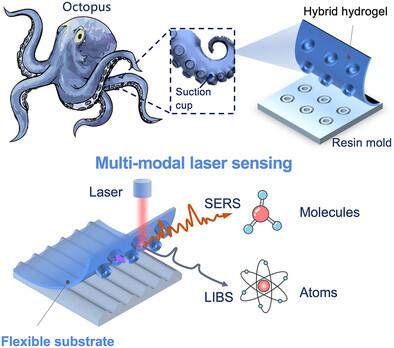受章鱼启发的多模态激光传感柔性等离子体阵列
IF 19
1区 材料科学
Q1 CHEMISTRY, MULTIDISCIPLINARY
引用次数: 0
摘要
有机和无机污染物的检测至关重要,因为它们对环境和健康有广泛的影响。尽管光谱技术为污染物分析提供了巨大的希望,但它们的应用往往受到采样和分析纹理、粗糙或非直接接触表面上污染物的挑战的阻碍。本文介绍了一种柔性的、受章鱼启发的、基于水凝胶的基板,该基板具有等离子吸盘阵列,用于多模态激光传感(表面增强拉曼散射(SERS)和激光诱导击穿光谱(LIBS))。吸盘内的微腔产生负压,促进与粗糙度深度(例如,高达300 μ m)的复杂表面或非直接可检测表面的牢固接触,从而有效捕获分析物。通过将水凝胶浇铸到3d打印模具中来制造吸盘阵列,从而实现精确和可定制的设计,以确认不同的表面轮廓。此外,等离子体材料(MXene和银纳米线),使光谱增强,被纳入聚乙烯醇形成衬底。然后,用SERS和LIBS分别对分子和原子分析物进行分析,具有良好的准确性和灵敏度。总的来说,这种柔性基板可以在复杂表面上进行精确检测,为环境监测、生物医学诊断和文化遗产保护提供变革性的解决方案。本文章由计算机程序翻译,如有差异,请以英文原文为准。

Octopus-Inspired, Flexible Plasmonic Arrays for Multi-Modal Laser Sensing
The detection of organic and inorganic pollutants is critical due to their widespread environmental and health impacts. Although spectroscopic techniques offer substantial promise for pollutant analysis, their application is often hindered by challenges in sampling and analyzing contaminants on textured, rough, or non-directly accessible surfaces. Here, a flexible, octopus-inspired, hydrogel-based substrate with plasmonic suction cup arrays for multi-modal laser sensing (surface-enhanced Raman scattering (SERS) and laser-induced breakdown spectroscopy (LIBS)) is introduced. The micro-cavities within the suction cups create negative pressure, facilitating firm contact to complex surfaces with roughness depths (e.g., up to 300 µm) or non-directly detectable surfaces for efficient analyte capture. The suction cup arrays are fabricated by casting hydrogel into the 3D-printed mold, enabling precise and customizable designs that confirm to diverse surface profiles. Additionally, plasmonic materials (MXene and silver nanowires), enabling spectroscopic enhancement, are incorporated into polyvinyl alcohol to form the substrate. Then, molecular and atomic analytes are analyzed by SERS and LIBS, respectively, with promising accuracy and sensitivity. Overall, this flexible substrate enables precise detection on complex surfaces, offering transformative solutions in environmental monitoring, biomedical diagnostics, and cultural heritage preservation.
求助全文
通过发布文献求助,成功后即可免费获取论文全文。
去求助
来源期刊

Advanced Functional Materials
工程技术-材料科学:综合
CiteScore
29.50
自引率
4.20%
发文量
2086
审稿时长
2.1 months
期刊介绍:
Firmly established as a top-tier materials science journal, Advanced Functional Materials reports breakthrough research in all aspects of materials science, including nanotechnology, chemistry, physics, and biology every week.
Advanced Functional Materials is known for its rapid and fair peer review, quality content, and high impact, making it the first choice of the international materials science community.
 求助内容:
求助内容: 应助结果提醒方式:
应助结果提醒方式:


